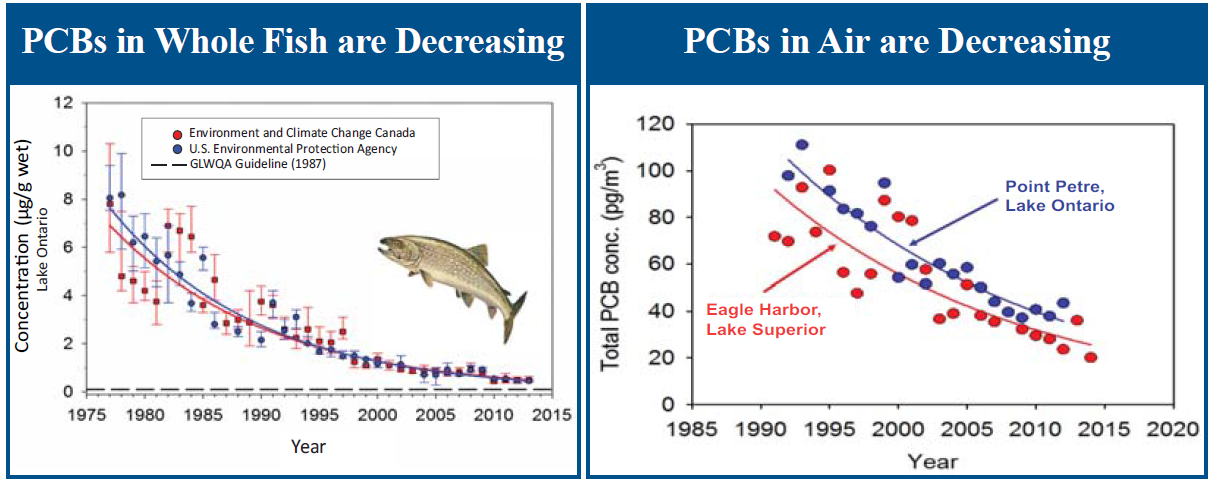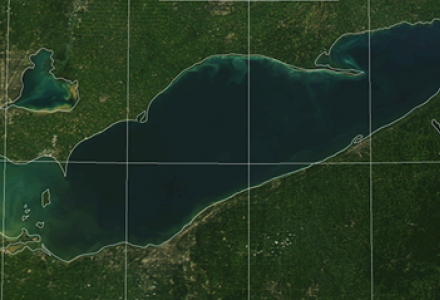
Although water quality in the Great Lakes is generally good, Canada and the US still lag behind in meeting goals to identify Chemicals of Mutual Concern and develop strategies to address pollution.
All of the Great Lakes have been degraded by human and industrial activities. The IJC has for many years called on governments to strengthen efforts to identify and stop these chemicals from entering the lakes.
Chemical pollution comes in many forms, from tiny invisible particles in the air or water that aren’t detectable by human senses to toxic substances like mercury from power plants in and outside the region. These harmful chemicals can pose risks to human health and affect drinking water quality.
Many chemicals build up over time (bioaccumulate) in the food web. Substances like dichlorodiphenyltrichloroethane (DDT) or polychlorinated biphenyls (PCBs) can remain in the Great Lakes ecosystem for long periods despite being banned by Canada and the US several decades ago. The good news is these banned substances are slowly diminishing over time in these ecosystems.
A graphic depicting PCB concentration trends in fish and air concentrations. Credit: State of the Great Lakes 2017 Highlights Report
The Great Lakes Water Quality Agreement (GLWQA) of 1978 required Canada and the U.S. to prohibit the discharge of toxic substances in toxic amounts and virtually eliminate the discharge of all persistent toxic substances. However, these goals have yet to be met. The list of hazardous and potentially hazardous substances created at the time included hundreds of substances and chemicals.
Over time, both governments have passed bans or regulations to reduce and eliminate production and use of toxic substances like PCBs, but new substances are continuously created that might pose health risks to humans, fish, and wildlife.
In the US, about 2,000 chemical substances are created each year. Previous chemical regulation had loopholes which limited the number of chemicals tested for safety. In 2016, Congress passed the Frank R. Lautenberg Chemical Safety for the 21st Century Act (LCSA) updating US standards and methods for protecting the public and environmental health. Despite this rule change, it could take the EPA decades to review the backlog of unregulated chemicals.
Canada regulates chemicals through the Chemicals Management Plan (CMP), adopted in 2006. Canada has evaluated nearly 23,000 chemicals which were in commercial use during the previous two decades. That process identified about 4,300 chemical substances that will require additional testing or evaluation. The CMP seeks to address the safety of all 4,300 substances by 2020.
The updated 2012 GLWQA continues to call for both countries to virtually eliminate all Chemicals of Mutual Concern (CMCs). CMCs are substances from human sources that pose a threat to human health and the environment. This is different from approaches in past versions of the GLWQA where a long list of hazardous substances was used. The 2012 GLWQA calls for Canada and the U.S. to jointly select and designate chemicals that pose a threat to human health and the environment, such as CMCs, in addition to developing binational strategies to address these CMCs.
As of 2018, only eight chemicals or categories of chemicals have been designated as CMCs. Public concern has been expressed about the slow pace of the CMC process, and the IJC shares these concerns. In its First Triennial Assessment of Progress (TAP), the IJC recommends governments accelerate work on binational strategies for elimination or continual reduction of CMCs with clear timelines set and met for strategy development and implementation. The IJC also recommends the governments implement the GLWQA principles of zero discharge, virtual elimination, accountability and public engagement, as well as Extended Producer Responsibility. The IJC further believes strategies to reduce pollutants in Great Lakes waters must contain clear timelines for the implementation of actions.
The IJC concluded in its TAP report that expanding and expediting the process of identifying more CMCs, and developing clear binational strategies to reduce or eliminate toxic substances are needed to meet each countries’ GLWQA obligations.

Michael Mezzacapo is the 2017-2018 Michigan Sea Grant Fellow at the IJC’s Great Lakes Regional Office in Windsor, Ontario.




